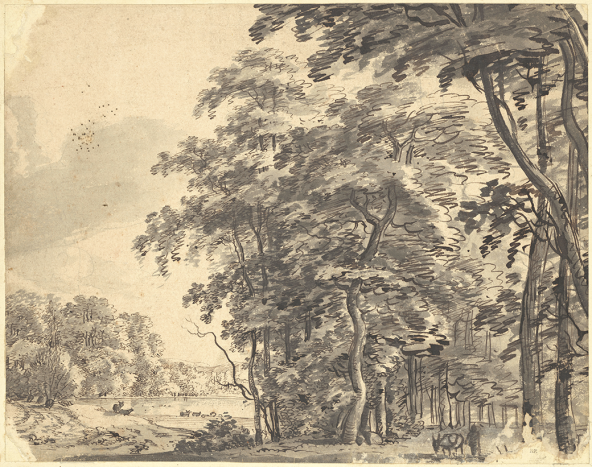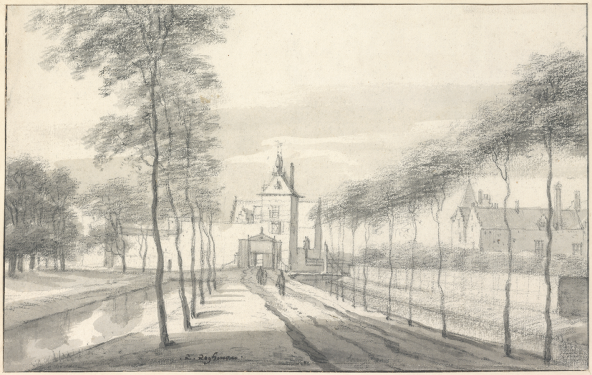Choose a background colour
Roelant Roghman, Dutch, 1627-1692: High Trees by a River with a Town in the Distance, c. 1650-55
Pen in brown ink with brown and gray washes on light brown paper; framing lines in brown ink.
9 3⁄4 × 11 3⁄4 in. (24.7 × 29.9 cm)
Recto, lower left, in brown ink, signed by the artist, R. Roghman; verso, lower left, in brown ink, C.I.(?) 185 and 5 – 5, and just to the right, p32, and in pencil, 30.
- Chain Lines:
- Horizontal, 24 mm
- Watermark:
- Strasbourg Lily, with a six-petaled flower below. Similar to Heawood, no. 1730.
- Provenance:
Possibly Gerard van Rossum, 1699 – 17721 ; possibly his sale, Amsterdam, De Winter and Yver, 8 Februrary 1773, lot 152 (sold to Nijman); Richard Collins, 1755 – 1831, England (Lugt 475); Rudolf Peltzer, 1825 – 1910, Cologne (Lugt 2231, stamp on verso); his sale, Stuttgart, H. G. Gutekunst, 13 – 14 May 1914, lot 332; Madame Toni Straus-Negbaur, died 1942 (Lugt 2459a, stamp on verso); her sale, Berlin, Cassirer, 25 – 26 November 1930, lot 88; Nicolaas Beets, 1878 – 1963; his sale, Amsterdam, 9 – 11 April 1940, lot 147; Bernard Houthakker (Lugt 1272, stamp on verso); his sale, Amsterdam, Sotheby Mak van Waay, 18 November 1975, lot 101; Galerie Julia Kraus, Paris; sale, Amsterdam, Christie’s, 26 November 1984, lot 67; Sheldon and Leena Peck, Boston (Lugt 3847); gift to the Ackland Art Museum, inv. no. 2017.1.71.
- Literature/Exhibitions:
Amsterdam 1964, 33, no. 85; Sumowski Drawings, vol. 10, 5038 – 39, no. 2233; F. Robinson in Chapel Hill, Ithaca & Worcester 1999 – 2001, 80 – 81, no. 23.
- Ackland Catalogue:
- 2017.1.71
Artists’ biographer Arnold Houbraken (1660-1719) called Roelant Roghman “a great friend of Rembrandt van Rijn.” Roghman is also considered one of the most experimental and prolific Dutch landscape artists of his day and may have also been one of Rembrandt’s pupils in Amsterdam. Here, Roghman emphasizes a lone traveler in the central foreground and uses a variety of pen strokes and selective washes to lead the viewer’s eye through a zigzag composition of alternating tree clusters, culminating in a distant, precisely rendered river fortress and town in the background.
Roelant Roghman was one of the most experimental and committed landscape artists of his day whose surviving drawings number far more than his paintings and prints.2
The present work demonstrates his full dynamic range, using both pen and brush in combination to set forth a wide range of strokes for effect and depth. The tree group that dominates the right side of the image exhibits virtuosic flourishes in the foliage, while his detailed rendering of the town and ships in the distance reveal his capacity for minute and precisely suggestive marks. Also notable is how effectively Roghman built volumetric space in the ground, riverbank, and tree branches. He used three different tones of gray wash, as well as a few strokes of the wash’s undiluted black ink source, skillfully integrating all of this brushwork with the brown ink lines that he laid down first with the pen. Signed by his own hand, Roghman clearly intended the sheet as a finished autonomous work, as was the case with the vast majority of his surviving drawings, few of which relate directly to his paintings or prints.
Because of the singular style of the foliage in this work, Werner Sumowski placed it in a special category of Roghman’s drawings that he dubbed the “zigzag group.”3
The word “corkscrew” might better describe the deft twisting of the branch ends. In any case, the Peck drawing arguably offers the most splendid example of this effect in Roghman’s oeuvre. Other drawings in this group vary considerably in scale and style, but similarly large sheets include a drawing in the Rijksmuseum, one formerly in the Jacobus Klaver collection, and a sheet in the Louvre.4
The latter drawing appears to be the closest surviving sibling to the Peck sheet in terms of style, though its condition has suffered from losses of paper at the corners Fig. 35.1.

Roelant Roghman, Pond in a Forest with a Figure and Donkey. Pen in black ink and gray wash on paper, 262 × 335 mm. Paris, Musée du Louvre, inv. no. 23220.
RMN-Grand Palais/Art Resource, NY
As with many of Roghman’s drawings, dating works belonging to the zigzag group is difficult. Roghman had a relatively long working life, spanning from 1645 to the 1680s.5
According to his first biographer, Arnold Houbraken (1660 – 1719), Roghman lived in the Old Mans’ Home (Oudemannenhuis) in Amsterdam in 1686 after a long career that extended into his old age.6
Only a small handful of drawings up to the year 1657 bear dates or are datable, yet they already display a remarkably broad range of style and finish. For instance, the large body of over 200 drawings made around 1646 – 47 of castles and manor houses that he documented while traveling around the Netherlands is quite different from the present work.7
These large sheets were executed in black chalk and wash and record the architectural beauty of the structures in their often-remote settings. Roghman’s clear propensity in this early series to experiment quite strikingly with foliage effects is relevant to our discussion. His View of Langerak Castle, for example, formerly situated on the Lek River east of Rotterdam, demonstrates how Roghman masterfully contrasted his graphic techniques in the rows of trees Fig. 35.2.8

Roelant Roghman, View of the Gatehouse and Langerak Castle, c. 1646 – 47. Black chalk and gray wash on paper, 206 × 327 mm. Paris, Fondation Custodia, Collection Frits Lugt, inv. no. 3602.
Fondation Custodia, Collection Frits Lugt, Paris
This drawing already bears his distinctive zigzag marks in the dangling foliage in the left-hand row. It is probably worth reconsidering, then, the usefulness of Sumowski’s concept of the zigzag group as a cluster of works, since similar foliage effects can be found in a wide range of Roghman’s drawings that appear to cross his career.
With that in mind, a relatively early date just on either side of 1650 can be proposed for the Peck drawing. It has previously been suggested that this drawing may have been made slightly later, during or after his trip to the Alps in the years 1654 – 57, due to foreign-seeming elements in the topography.9
This river fortress and town, however, could also be Dutch, especially given the architecture of the two church spires and the rows of gables along the wharf. Heavily fortified towns along river estuaries were common in South Holland and Zeeland in these years, with fortresses that were still active up to the end of the Eighty Years’ War in 1648. Despite the difference in style with the black chalk castle series from 1646 to 1647, a few other examples of pen and wash drawings like this one appear to come from these years as well, such as his depiction of Zandvoort that he used for an etching made before 1652, and a landscape drawing from the De Grez Collection from circa 1651.10
Both of those works share the precision and tightness of the present work, which contrasts strikingly with Roghman’s larger body of looser and sketchier pen and wash drawings that date from the 1660s onward.
End Notes
Dumas 2015, 245 – 46. The early provenance as part of Van Rossum’s collection was proposed by Dumas based on similarity in dimensions and description in the 1773 sale of his collection, lots 151 – 52, paired with a drawing now in the Rijksmuseum, Amsterdam (inv. no. rp-t-1887-a-1383).
Roghman’s surviving drawings likely number over 300, of which 212 compose the castle series catalogued in Van der Wyck & Kloek, 1989 – 90; for a selection of the remainder, see Sumowski Drawings, vol. 10, passim.
See Sumowski Drawings, vol. 10, under no. 2248 (the present work), with a cursory list of eight others that Sumowski also puts in this group.
Amsterdam, Rijksmuseum, inv. no. rp-t1887-a-1383; see online entry by A. Stefes in Turner 2018: hdl.handle.net/10934 /RM0001.collect.60396 (accessed 16 March 2020). For the ex-Klaver drawing, see entry by Schatborn in Amsterdam 1993, no. 48; subsequently auctioned at Sotheby’s, Amsterdam, 5 November 2002, lot 58. Paris, Musée du Louvre, inv. no. 23220; see Lugt 1929 – 33, vol. 2, no. 662.
For the early drawings, along with general issues related to Roghman’s oeuvre, see Kloek in Van der Wyck & Kloek 1989 – 90, vol. 2, 15 – 39.
Houbraken 1718 – 21, vol. 1, 173 – 74. For archivally based biographical data, see Kloek, Dudok van Heel, and Bok in Van der Wyck & Kloek 1989 – 90, vol. 2, 1 – 14.
See Van der Wyck & Kloek 1989 – 90 for a study of this series. For further reflections on its possible patron, see Plomp 1997, 322 – 23.
Paris, Fondation Custodia, inv. no. 3602; see Schatborn 2010, no. 150. The castle was demolished in the eighteenth century
A. Stefes in Turner 2018 (as in note 4 above). For the evidence, which is only visual rather than written (i.e., documented in his drawings) that Roghman made the trip to the Alps and even to Italy, see the useful summary under Schatborn 2010, no. 155. The suggestion that Roghman’s drawing in Weimar (inv. no. KK 5329) was made in Italy, perhaps Venice, is less convincing; see Leonoor van Oosterzee in Amsterdam 1999, 94 – 95.
Plomp 1997, no. 395; Brussels, Amsterdam & Aachen 2007 – 08, no. 69. Some comparable pen work can also already be found in Roghman’s 1646 – 47 castle series; see, for example, Swieten Castle in Van der Wyck & Kloek 1989 – 90, vol. 1, no. 187; and Milwaukee 2005 – 06, no. 85.
